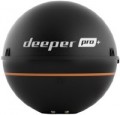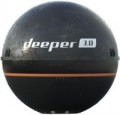the
maximum depth at which the sonar locator (see "Type") is able to operate effectively — in other words, how deep underwater the device is able to "see".
It is worth choosing an echo sounder according to this parameter, taking into account the actual depths at which it is planned to be used. Of course, this does not place a certain margin, but within reasonable limits (15-20%, less). For example, it hardly makes sense to specially take a model with a scanning depth of 200 m for a lake with pits of 30-40 m — such devices are expensive, while there will simply be nowhere to realize their full potential, and a powerful signal can also scare away the fish. But for marine or oceanic applications, a depth of a kilometer or more may be required; the most advanced echo sounders are quite capable of providing it.
—
Ethernet. This standard is also known as LAN or RJ-45. Its original purpose is the construction of general-purpose wired computer networks; however, Ethernet can also be used in special networks — including used by navigation equipment. Note that this interface is technically capable of providing a higher data transfer rate than NMEA, so it can be used for tasks that require the transfer of a large amount of data — for example, connecting to the Internet via a satellite module.
—
NMEA. Abbreviation for "National Marine Electronics Association", "National Marine Electronics Association". This interface is used to interconnect various "marine" electronics, mainly navigation — echo sounders, chartplotters, radars, VHF radios, gyrocompasses, sensors in engines, etc. Accordingly, its support allows you to connect the device with other specialized devices and sensors. Note that there are several versions of NMEA. The most popular at the moment is NMEA 0183, it is this standard that is supported by most special equipment. A more advanced version is NMEA 2000, which is not yet widely used. More information about the different versions and their compatibility can be found in special sources.
—
Output for external GPS antenna. This function can occur regardless of whether the device has a built-in GPS receiver (see above). If such a receiver is not available,
...then the ability to connect an external antenna (more precisely, a whole GPS module) is almost mandatory for devices with the chartplotter function (see "Type") — otherwise they will not be able to effectively perform their tasks. However, for models with their own receiver, an external antenna may come in handy — it is usually more sensitive than the internal one and allows you to more accurately determine the location of the device, especially in difficult conditions (atmospheric interference, navigation through narrow fjords, etc.). At the same time, such an antenna can be chosen at will, choosing the best option for price and functionality. One has only to take into account that different types of connectors can be used to connect external equipment — therefore, before buying an antenna, it would be useful to clarify its compatibility with a specific model of the device.
— Wi-Fi. A wireless interface, originally designed to connect to local computer networks, and more recently also used to directly connect various devices to each other. It can be used in echo sounders/chartplotters for various purposes — both for integration into the onboard network and for connecting external equipment (wireless sensor, remote control tablet, etc.); specific functionality depends on the model.
— Bluetooth. A wireless interface used to connect different devices to each other. The Bluetooth standard includes many separate protocols for different types of data and formats of operation; in fact, the possibilities of this connection in each particular case depend on what protocols the echo sounder / chartplotter supports. The most common features include, in particular, connecting wireless sensors (see above), exchanging data with a tablet, laptop or other gadget (for example, to download new maps and routes), connecting wireless headsets to work with sound alarms, etc. P.
— Video input. Connector for connecting an external video signal to the echo sounder / chartplotter. This feature allows you to use the display to display a "picture" from another device, such as an external camera. Note that video inputs are found mainly in models with large colour displays — without such a display, the whole point of this function would be lost.
— Video output. Connector for video signal output from echo sounder/chart plotter. This function allows you to duplicate the image from the display of the device on an external large screen — for example, the main monitor of the on-board computer — which makes viewing more convenient.
